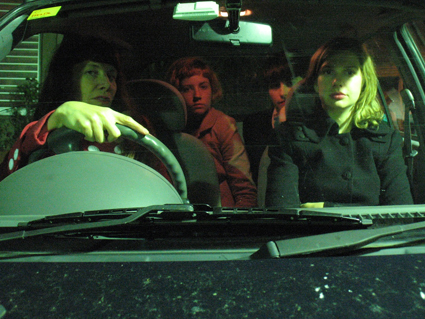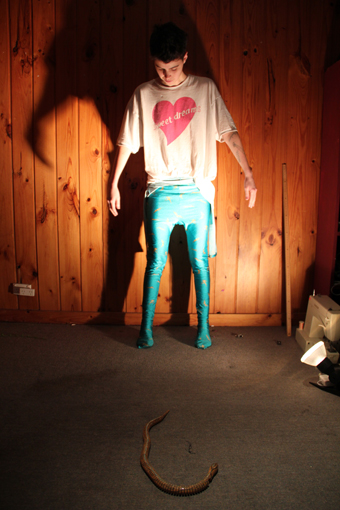from the ground up
keith gallasch: imogen semmler, director, underbelly festival

Spotlight Bunny, Julie Vulcan, Ashley Scott & Friends with Deficits
courtesy the artists
Spotlight Bunny, Julie Vulcan, Ashley Scott & Friends with Deficits
ONE OF THE MOST IMPORTANT DEVELOPMENTS FOR PERFORMANCE IN RECENT YEARS HAS BEEN THE EMERGENCE OF YOUNG INDEPENDENT PRODUCERS, FESTIVAL DIRECTORS AND CURATORS. MANY ARE WOMEN, OFTEN WORKING IN TEAMS AND PRODUCING EVENTS THAT PRESENT BUT ALSO NURTURE NEW WORK—DRAMATURGICALLY BUT ALSO IN TERMS OF MANAGEMENT, RISK AND TECHNICAL AWARENESS. IMOGEN SEMMLER IS ONE SUCH PRODUCER CREATING UNDERBELLY IN 2007, A FESTIVAL WHICH SUPPORTS INDIVIDUAL ARTISTS AND GROUPS, EMERGING AND ESTABLISHED, WORKING IN A VARIETY OF PRACTICES. THIS YEAR THE THREE-WEEK WORKSHOP AND PERFORMANCE DAY WILL BE STAGED ON SYDNEY’S COCKATOO ISLAND.
Underbelly in 2011 predictably includes a diverse range of projects. Here’s a few examples. The Sexy Tales Comedy Collective will develop a theatre and music work titled 100 Years Of Lizards. Neil Brandhorst’s Horizon will be an installation that “disrupts the sensory information required to make sense of the environment…revealing how previous experiences provide meaning in new situations, and result in the feelings and urges that become our behaviour.” Spotlight Bunny, a work conceived by Sydney performance maker Julie Vulcan working closely with sound maker Ashley Scott and emerging performance collective Friends with Deficits to “explore location, the influence of soundtrack and the slippery nature of context. Influenced by drive-in culture, it blends the past with today’s iPod culture in an intimate performance for four audience members at a time in a stationary car.”
In Inflate My Heart With 1000 Gushes Of Wind, Swanbrero will “insert a piece of Parramatta Road into the natural wonderland of Cockatoo Island. The work will experiment with large-scale interpretive choreography, costume and wind to create melancholic spectacle.” The group (Corey Crushcore Dreamlover and Lara Thoms) describe themselves as “faded, cheap, fraying and bending over so far that their heads are scraping the ground.”
Tell me about starting up Underbelly and why you did it?
I come from an events background, working on different festivals and putting on little events myself—sort of underground. I liked the idea of bringing a lot of artists together in a festival but also starting with the development of their projects. Having artists together you’d see them make great connections, but it was fleeting and then they were off. So I thought it would be good to bring development and presentation together under the one roof.
Secondly, I felt there was a lot of stuff happening in Sydney at the time that was perhaps a bit hard to access, say about five years ago. There were great underground spaces but you had to be in the know. This was pre-emailing list, pre-Facebook, so it was more text messages or word of mouth. I started talking to groups who I’d been working with or knew of and put together a group of local artists with projects.
The first year was very much curated. I came up with the concept and just did it with people I was interested in and staged it at CarriageWorks. The second year we did it there again but it was open to applications—a lot of people said, how can we get involved? So that process has continued, which has been great.
You’re still curating or is it more like a fringe festival model?
We have a curating committee—applications come in and we choose projects. We have certain loose criteria—to support emerging artists and artists experimenting with new forms or more established artists pushing themselves in new directions or wanting to do more research-based work.
Would you or your committee have seen much of the work?
Not necessarily. We focus on new work. Artists have to have a pretty good argument as to why their work should be included because the whole idea of the residency is to present something for the first time. Sometimes it’s a work in progress. Some projects develop just a few scenes or the beginning of an idea.
And audiences watch the development?
Yes. We’ve had shows that have gone on to become fully formed and feature at fringe festivals or Next Wave. It’s good to get projects at an early stage—they need the lab time.
So you’re providing a service for people to innovate. Do you charge artists for that?
No. This year we’ve developed a project fund. It’s not a huge amount of money but we want to resource projects. We don’t want artists to be out of pocket. If they come with an existing grant or other support, that’s great but we do try as best we can to facilitate their project; that includes technical support, publicity, marketing, the venue…And we provide a lot of mentoring. For a lot of the artists, this might be the first time they’ve been involved in a festival. We help them with producing, budgeting, maybe the technical side of producing and we ask them all to do risk assessments. They might not have done that before so we’re happy to hold their hands and take them through the process. But we’re not doing it for them—we make sure they learn. There’s a lot of contact. We have a producer who works directly with the artists. I did this in the first few years but now we’re expanding.
How many of you are there?
At the moment there’s Clare Holland, our executive director, and myself. In two weeks we’ll have our event producer Jenn Blake and then we’ll have a production manager, a technical co-ordinator and a marketing co-ordinator, a publicist and an artist co-ordinator, like a program co-ordinator who manages all the artists. So it’s a big team!

Corey Crushcore Dreamlover, Inflate My Heart With 1000 Gushes Of Wind, Swanbrero
courtesy the artists
Corey Crushcore Dreamlover, Inflate My Heart With 1000 Gushes Of Wind, Swanbrero
Does the income from box office keep the event afloat?
Box office is a very small part of our income, mainly because the lab is running for three weeks prior to the festival which is a one-day event—and we try to make the tickets quite cheap, around $15 to $20. It’s a bit like a music festival where you choose shows and wander round installations. You get to see the whole gamut of what’s on offer. We started out with very little money, but CarriageWorks was a great venue partner—they gave us a lot of in-kind support.
We set up as a not-for-profit organisation and grew gradually. We started getting support from the City of Sydney, set up more formally in 2009, and had a year off because I realised it wasn’t going to be sustainable if we just kept doing it on a shoestring.
We get Arts NSW funding and we’ve recently received first time Australia Council funding for this event through the ARI [Artist Run Initiative] fund. We’ve also found really interesting partnerships with foundations whose interests are aligned with ours, and we have an amazing board.
How do audiences engage with Underbelly?
During the lab, we run tours. We invite the audience to come and watch the projects in development. One of us will take you round and you’ll meet the artists. And what’s happening more and more, because of the audience component at the lab, is that artists are applying with projects that need the audience for development—maybe content generation or particular feedback or testing things or interactivity or even making or building things. So that allows the lab experience to be really fun for the audience and it’s also giving artists unique access to the public through a residency. So it’s not just a work in progress showing. It might be the I Can Draw You a Picture team—they made a printed publication last year with the audience generating the content during the lab.
We call this the Public Lab. People can come pretty much every day for 10 days of the three weeks. You can come out to the island and do a tour. Projects that really require audience participation might want two hours a day. So we’ll pop that in the lab calendar that from, say 1-3pm, head out to the island and you can take part in this project. There’ll be social experiments where the audience become active participants. A quarter of our projects would have that component but it’s often those that then go on to other festivals. There’s a real live art push and I think that term is constantly evolving where once it was performance art or contemporary performance. In this area huge boundaries are being blurred between audience and artists and participants.
What characterises the works that appear in Underbelly?
We have a lot of installation, works by visual artists and filmmakers. We’ve had a couple of dance films over the years—the dance pieces are created on site, filmed, edited and shown. A filmmaker last year made a 3D video where you looked through a little box. He did it with really cheap technology because he’d been working in really high-end production for big companies but he wanted to show people how you could do it really cheaply and easily using a few mirrors and an old monitor. We also have a lot of dance and theatre. We’ve had the classics—Pig Island and Eddie Sharp. Whale Chorus are back this year with a project. There a lot of emerging and experimental theatre people, a lot of hybrid stuff, a lot of blending and theatre work like Eddie Sharp’s Some Film Museums I Have Known (shown at the Old Fitzroy recently).
The word that was associated with Underbelly for a while was “underground.” Is that still a viable term?
I think it’s really moved on, particularly in Sydney. The “underground” as it was five years ago has really blossomed through different changes such as to the licensing laws, the support of FBi Radio, the inner west venues—different elements that have brought that culture out into the open. For years you heard that there wasn’t much going on in the arts unless you were in the know. Now people are saying, “oh wow there’s heaps of stuff happening.” You see it in events like Tiny Stadiums, Imperial Panda, new venues, Performance Space’s LiveWorks and their Clubhouse. A lot of it is because groups have come out of what was the underground five or 10 years ago.
Is Underbelly becoming more of a full-time job?
It’s becoming more full-time, which is great. Bringing Clare Holland our executive director in has been a huge part of that—the ability to work year-round and find the funding to do it. It’s not full-time but it’s definitely part-time most of the year. I do other independent producing work. I did the Statues Project for City of Sydney’s Art and About last year and I produce some theatre for other people. I do research for documentaries in my other life. It’s about juggling. I think making Underbelly sustainable has been a really big focus. .
You usually get a good turnout on the big day. How many are you anticipating this year?
We’ll expect maybe 1200-1500 if it’s a nice day. If it’s raining, it’s about who wants to get on the ferry. The thing is, people like going out to Cockatoo Island. Even though it’s winter. I think the Biennale has shown that everyone’s still pretty happy to go out there and its all under cover. You don’t have to worry about getting wet—you just don’t take your jacket off.
Underbelly Arts, Underbelly: Public Lab, July 3-12; Festival, Cockatoo Island, Sydney, July 16 , http://underbellyarts.com.au
RealTime issue #103 June-July 2011 pg. 34






